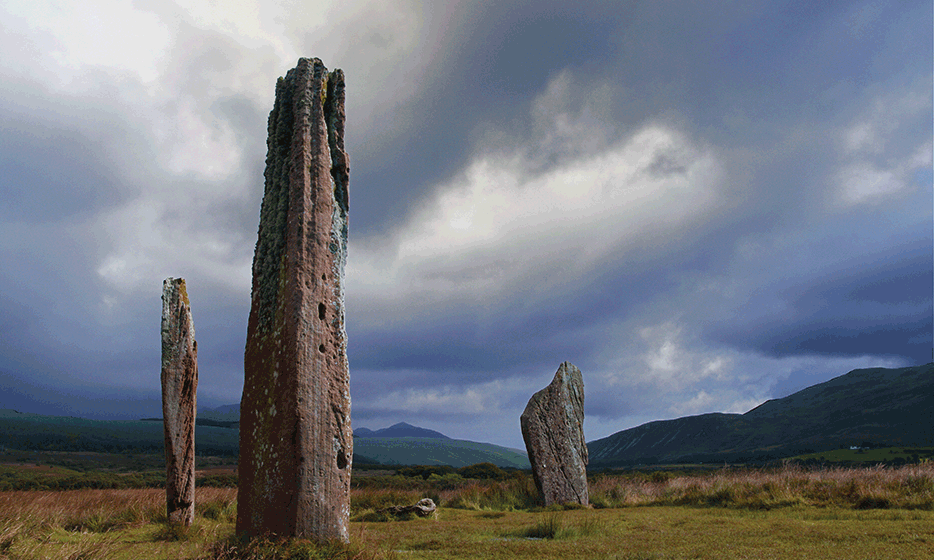Rocks of ages: Broomend of Crichie, a circle henge in Aberdeenshire, Scotland
Photo: Colin Richards © Fletcher8
The Latin tag abi tu, et fac similiter—go, thou, and do likewise—was widely encountered in the 17th and 18th centuries. It is over the gates of pious enterprises such as almshouses and schools, as well as in the flyleaf of a curious book, An Account of What Seem’d Most Remarkable in the Five Days Peregrination of … Messrs Tothall, Scott, Hogarth, Thornhill and Forrest. The volume was published by Richard Livesay in 1782 at the behest of Jane Hogarth, widow of one of the five men in the title, although in truth the five days in question, an impromptu tour of west Kent and the Isle of Sheppey back in May 1732, had been more piss-up than pilgrimage.
The artist William Hogarth and his friends were not able to explore any Neolithic sites, which tend to be found in stonier lands to the north and west. Their scrutiny of churches and bas-reliefs often played second fiddle to big lunches and horseplay involving nettles and cow dung. But the point of departure for their jaunt was a burgeoning belief that deep truths about a territory could be revealed by interrogating its monuments—and not just in the pages of books, but in the field. Hogarth, the writer Ebenezer Forrest and the others were not any great shakes as antiquarians (though they did document their journey in various ways), but they were psychogeographers avant la lettre.
Colin Richards and Vicki Cummings—professors of archaeology at the universities of the Highlands and Islands, and Cardiff respectively—are likewise keen for their readers to go and do likewise. “During a visit,” they exhort, “instead of just following a path to the monument and returning the same way … spend time walking around the ring to examine its placement in relation to the local topography … Investigate how the stone circle relates to other sites and monuments … Finally, contemplate the overall effect of standing in the middle.”
Richards and Cummings stop well short of the baroque mysticism of the ex-Teardrop Explodes frontman turned countercultural man of letters and self-styled “drude” Julian Cope, whose 1998 book The Modern Antiquarian covers some of the same territory as Stone Circles: A Field Guide, albeit in a more excitable vein, but they are acutely aware that our fascination with these sites is a matter not just of scholarship, but of romance.
Focused on the British Isles, Stone Circles is informed by the fistful of methodologies available to the 21st-century field archaeologist—magnetometry, aerial photography, radiocarbon dating, lithology and more—alongside good old stratigraphic excavation (indeed, there are a few sideswipes at the “casual digging” of earlier explorers). Standing stones can be precisely identified with not just the quarry but the seam from which they were extracted. The organic materials which might make some sort of sense of these mute monoliths, and which only survive in tiny quantities—wood, textiles, human and animal remains—are fiercely interrogated. Yet the overwhelming feeling remains that we know what these things were for and how they worked only in the very vaguest sense.
They may incorporate burial sites or be oriented towards them; they may “talk” to neighbouring circles or natural features such as rivers or mountains via “avenues” or the positioning of a principal entrance. They may have been surrounded by more everyday human activity. Or they may not. The stone that could have illuminated a particular relationship with sun, moon or stars may have subsided, or fallen over, or been tractored off-site to make a cowshed.
The book’s very specificity allows for a fairly general approach to context. The dolmen or cromlech-type burial sites found relatively often in Wales and Ireland are considered only if they relate to one or more stone circles. Skara Brae on Orkney, one of the best-preserved “domestic” sites north of the Mediterranean, is mentioned only in passing, on account of its proximity to a quarry.
A certain amount of anecdote and folklore is permitted here and there, partly to fill the gaps (though there is no Cope in the bibliography). Occasional references to conveniently situated hostelries may have some readers thinking of Toby Jones and Mackenzie Crook in BBC TV’s Detectorists. Nevertheless, this seems to me—and I’m a bit of an enthusiast for these sites (albeit very much one of a sentimental rather than a scholarly stripe)—to be an absolutely exemplary book. It is thorough, navigable—the colour-coded display copy (set in the impeccably neo-romantic Albertus font) helps you find your way around the archipelago—authoritative and engaging.
• Colin Richards and Vicki Cummings, Stone Circles: A Field Guide, Yale, 520pp, 147 colour illustrations, £30 (hb), published 10 September
• Keith Miller is an editor at The Telegraph and a contributor to titles including the Literary Review and The Times Literary Supplement

